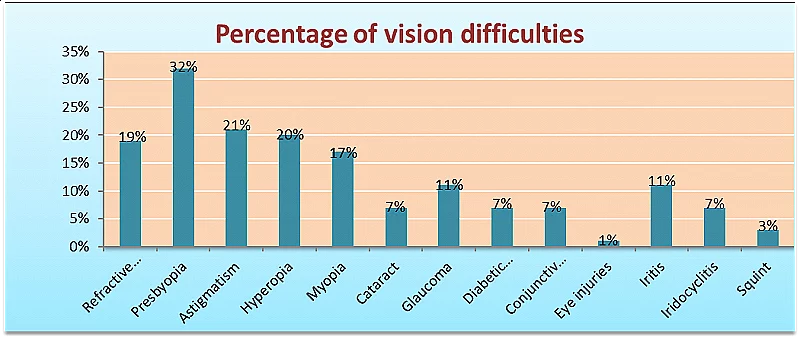Institutional Distinctiveness
“Screening Today for Healthier Tomorrow”
“Preventive and Promotive focus-on the health status of patient caretakers.”

Introduction
The college has established its distinctive approach towards the comprehensive vision of providing quality health care service to the society by screening the vision of caretakers (Patients family members) of patients admitted in a hospital in order to eliminate the main cause of all preventable and treatable blindness as per Global Initiative vision 2020.
The thrust area of the institution is “preventive and promotive focus-on the health status of patient caretakers”
“Screening today for a Healthier Tomorrow”.
The primary purpose of vision screenings is to identify early signs of disease in order to implement early treatment and reduce the emergence of that disease. Screenings should only be done when they are proven to be beneficial. According to the World Health Organization (WHO), “screening is warranted for conditions that represent important health problems, for which the natural history is known, and for which suitable tests and accepted treatments in the early stages are available. The value of a screening test is determined by its ability to distinguish a diseased from a normal, non-diseased state.
The Visual function is important for optimal orientation in functional and social life and has an effect on physical and emotional wellbeing. Visual impairment, therefore, leads to restriction in all aspects of daily living and is related to the quality of life.
In this regard, the college has initiated to conduct screening to the caretakers of the patients (family members/ relatives of the patient) admitted in a parent teaching hospital. The screening focused on identifying the common visual defects and its related predisposing risk factors influencing the visual defect for early detection, diagnosis and treatment.
The Internship students, faculty of SDUCON and staff of RLJH&RC (Dual role integration staff) aimed to conduct screening in the hospital for all the caretakers with a defined screening tool. The purpose of screening the caretakers is to identify people in an apparently healthy population who are at higher risk for visual defects.
Objectives of this practice include:
- To screen the health status among the caretakers of patients admitted to a parent teaching hospital.
- To identify the predisposing risk factors influencing the visual impairment and its risk Factors,
- To create awareness on healthy lifestyle for promotion and prevention of common Visual defects/ diseases.
- To have an easy reference for prompt diagnosis
Highlights of the screening:

Text box item sample conteMajority of 240(48%) of the study participants were between the age group of 30-49 years and Majority 347(69%) of the participants were females. Majority 443(89%) of the participants were married and 333(67%) of the participants had no formal education, and Majority 64 % (320) of the participants were from a rural area and 293 (59%) of the study participants were performing the moderate work. Majority 440(88%) of the participants had normal BMI and Majority 437(87.4%) participants were not having a family history of eye disorders. Majority 453(91%) were not having any pre-existing history and Majority 230(46%) of the participants were having vision treatment or diagnostic test related to vision difficulty and 177(35%) of the patient's caretakers was admitted in surgical wards. Majority of 160(32%) of the study participants had presbyopia, 107(21%) of the participants had astigmatism and 100(20%) of the participants had hyperopia. 97(19%) of the participants had refractive errors and only 05(1%) of the samples had a different kind of eye injuries Conclusion: There is a significant percentage of prevalence of vision difficulty and risk factors of vision difficulties are present among the public which affects the quality of life of the caretakers and it also affects the life of patients who are depending on the caretaker too. Thus, the college aims to eliminate all possible avoidable blindness among the general public. Let’s pledge for a future vision of the Nation – to keep the eye open for Good Vision.nt
